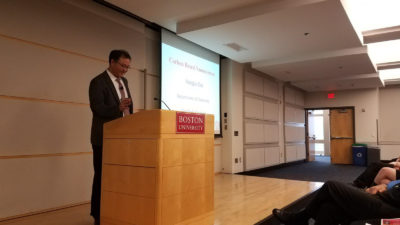
From noninvasive imaging to a new form of energy, professor Hongjie Dai of Stanford University showed Boston University the fruits of persistent research.
The new Schlumberger Annual Materials Science Lecture started this year with Dai discussing his research in carbon-based nanoscience. The two-part Friday lecture dove into bio-fluorescent imaging and the new aluminum graphite battery he has developed.
David Bishop, the head of the Boston University division of materials science and engineering, said it was an honor that Schlumberger — an oil company that specializes in material science — would sponsor the series and that the division could bring world-class researchers to BU students.
“It’s an honor to have [Dai] come visit us,” Bishop said. “What we’re trying to do is tell our students to aspire to do world class research and show them a role model at the cutting edge of the field.”
After introductions, Dai explained his research on unzipped carbon nanotubes and how that led to the expansion of his research into the two main developments he showcased. He discovered that when nanotubes were injected intravenously into test mice, imaging machines greatly benefited and scientists could see the internal systems of the mouse with significantly more ease.
This allows for noninvasive imaging, specifically brain imaging. Even though this is an alternative to dyes and intrusive surgery, the nanotubes take a longer time to exit the body, up to a few months, Dai said. There is speculation of the effects on the body because of this.
The most recent innovation of Dai’s lab are rechargeable aluminum ion batteries, resilient up to 14,000 charges. By combining aluminum, graphite and salts, Dai created a battery that is cheap and has potential to replace the lead acid industry.
“You use lead acid every day … in your car, in buildings, even in golf carts,” Dai said. “In third world countries, there’s nowhere for this to go, no one to recycle it. I would like this to replace lead acid. No more lead acid anywhere.”
Dai explained that even though this project was first developed in 2015, it is still undergoing developments and many are coming up with innovative uses. For example, the battery was used to power a motorbike recently in Taiwan, and there is a startup in Palo Alto, California trying to commercialize the battery.
“This battery can even last up to -30 degrees Celsius. It would even work here in Boston,” he joked.
He stressed the importance of persistence in projects like this, and in all research that BU students are doing.
“Nothing is going to be smooth. I had many failures as well. I came here after a lot of failures and struggles,” he said. “Keep working at what you believe in and good things will happen.”
Nikunj Kheton, a College of Engineering junior, said that he has been interested in Dai’s work for a while and even had friends from his hometown of the Bay Area intern in Dai’s lab. He was surprised and interested in how far Dai has come from his original research.
“It’s exciting to see this perspective and approach to the nanoscience,” Kheton said. “I have a couple of research projects going on and it’s always good to hear these kinds of things for idea generation. It’s good to be exposed to it,” he said of the lecture series.
Dai said that it is important for him to be there to convey the impact that continuous innovation can have on the world.
“I want to show them that science can have impact to real problems, like in medicine and energy,” Dai said. “Getting a result to be used to solve real problems in the real world can be the best recognition of the science.”



























































































































